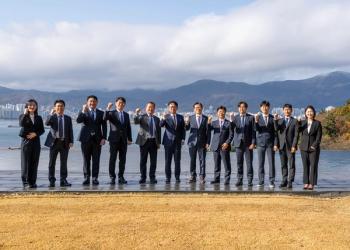
Enhanced air cooling achieves 1,650 ºC TiT
Mitsubishi Hitachi Power Systems (MHPS) has traditionally targeted high Turbine Inlet Temperatures (TiT) as the best way to increase the efficiency of gas turbines and the corresponding combined cycles. Among the latest techniques it is using to achieve this is the enhanced air cooling system that has been tested at its T-Point power plant in Japan.
Below are excerpts from a paper authored by Carlos Koeneke, vice president of project engineering at MHPS Americas.
Traditional air cooling designs involve ingestion of air, represented by the curved blue arrows in the lower left corner of Figure 5. This results in dilution of the hot gas into a lower TiT. Under this scenario, a higher flame temperature is required to achieve an elevated TiT with the consequential increase in NOx emissions. The closed circuit steam cooling eliminates the dilution of the hot gas and therefore allows a high TiT while containing NOx emission levels.
Concept of the combustor cooling system for high TiT MHPS latest design targeting high efficiency with low NOx emissions is called enhanced air cooling. This new system is based on extraction and cooling of a small fraction of the GT compressed air using an external cooler. A single stage radial boost-up compressor is then used to provide the required cooling air mass flow to the combustion liners, as shown in the upper part of Figure 6.
This cooled air is circulated through a jacketed transition piece arrangement, similar to the steam cooled counterpart, and is mixed with the combustion air after removing heat from the combustion hardware, in a semi-closed configuration. Figure 6 illustrates the concept and shows the application of the single stage radial boost-up compressor.
The supply of cooling air to the combustor in the Enhanced Air Cooling system is also used to optimize the Turbine Row 1 and 2 tip clearances. The air supply line is provided with a three-way valve that allows diverting the cooling air through the blade rings prior to entering the transition piece and combustor, as shown in Figure 7.
During start up, when large clearances are required, the cooling air is routed directly to the transition piece without any effect on the turbine blade tip clearances. After a predetermined load, the three-way valve is used to redirect the cooling air flow through the blade rings to reduce the blade tip clearance and improving the gas turbine efficiency. The graph in the bottom of Figure 7 shows measured tip clearance of Row 1 Blades confirming the effectiveness of the clearance control approach. In addition to improving PowerGen Intl 2016 Page 10 performance at high loads, this capability to increase or reduce clearance enables faster ramp rates and improved flexibility.
The original steam cooled J started commercial operation at the T-Point validation power plant in July 2011. This unit was successfully converted to air cooling in 2014, following the same approach applied to the G to GAC conversion. This modified JAC unit was operated and validated through short-term validation followed by long term operation at the validation facility. The Enhanced Air Cooling concept was subsequently applied to the T-Point unit in May 2015, after confirming that the basic air cooled version operated reliably. Both, the original JAC and the Enhanced Air Cooling JAC have operated with good results and reliability.
The Enhanced Air Cooling M501JAC has demonstrated solid reliability reaching 1,650 ºC TiT while temporary instrumentation data confirmed all operating parameters within expectations
Newsletter
Power your knowledge with the latest in turbine technology, engineering advances, and energy solutions—subscribe to Turbomachinery International today.





